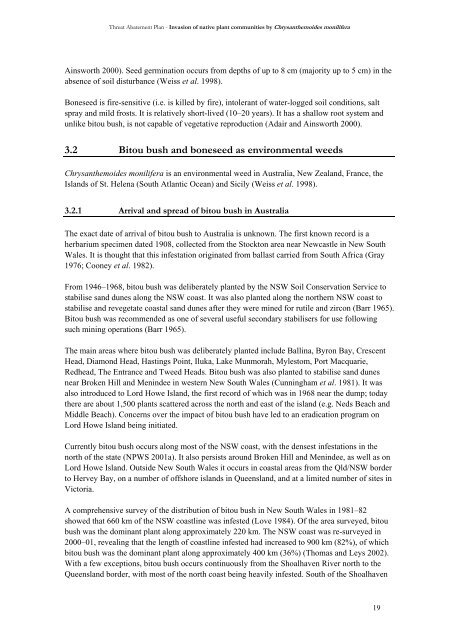NSW Bitou Bush Threat Abatement Plan - Department of ...
NSW Bitou Bush Threat Abatement Plan - Department of ...
NSW Bitou Bush Threat Abatement Plan - Department of ...
Create successful ePaper yourself
Turn your PDF publications into a flip-book with our unique Google optimized e-Paper software.
<strong>Threat</strong> <strong>Abatement</strong> <strong>Plan</strong> - Invasion <strong>of</strong> native plant communities by Chrysanthemoides monilifera<br />
Ainsworth 2000). Seed germination occurs from depths <strong>of</strong> up to 8 cm (majority up to 5 cm) in the<br />
absence <strong>of</strong> soil disturbance (Weiss et al. 1998).<br />
Boneseed is fire-sensitive (i.e. is killed by fire), intolerant <strong>of</strong> water-logged soil conditions, salt<br />
spray and mild frosts. It is relatively short-lived (10–20 years). It has a shallow root system and<br />
unlike bitou bush, is not capable <strong>of</strong> vegetative reproduction (Adair and Ainsworth 2000).<br />
3.2 <strong>Bitou</strong> bush and boneseed as environmental weeds<br />
Chrysanthemoides monilifera is an environmental weed in Australia, New Zealand, France, the<br />
Islands <strong>of</strong> St. Helena (South Atlantic Ocean) and Sicily (Weiss et al. 1998).<br />
3.2.1 Arrival and spread <strong>of</strong> bitou bush in Australia<br />
The exact date <strong>of</strong> arrival <strong>of</strong> bitou bush to Australia is unknown. The first known record is a<br />
herbarium specimen dated 1908, collected from the Stockton area near Newcastle in New South<br />
Wales. It is thought that this infestation originated from ballast carried from South Africa (Gray<br />
1976; Cooney et al. 1982).<br />
From 1946–1968, bitou bush was deliberately planted by the <strong>NSW</strong> Soil Conservation Service to<br />
stabilise sand dunes along the <strong>NSW</strong> coast. It was also planted along the northern <strong>NSW</strong> coast to<br />
stabilise and revegetate coastal sand dunes after they were mined for rutile and zircon (Barr 1965).<br />
<strong>Bitou</strong> bush was recommended as one <strong>of</strong> several useful secondary stabilisers for use following<br />
such mining operations (Barr 1965).<br />
The main areas where bitou bush was deliberately planted include Ballina, Byron Bay, Crescent<br />
Head, Diamond Head, Hastings Point, Iluka, Lake Munmorah, Mylestom, Port Macquarie,<br />
Redhead, The Entrance and Tweed Heads. <strong>Bitou</strong> bush was also planted to stabilise sand dunes<br />
near Broken Hill and Menindee in western New South Wales (Cunningham et al. 1981). It was<br />
also introduced to Lord Howe Island, the first record <strong>of</strong> which was in 1968 near the dump; today<br />
there are about 1,500 plants scattered across the north and east <strong>of</strong> the island (e.g. Neds Beach and<br />
Middle Beach). Concerns over the impact <strong>of</strong> bitou bush have led to an eradication program on<br />
Lord Howe Island being initiated.<br />
Currently bitou bush occurs along most <strong>of</strong> the <strong>NSW</strong> coast, with the densest infestations in the<br />
north <strong>of</strong> the state (NPWS 2001a). It also persists around Broken Hill and Menindee, as well as on<br />
Lord Howe Island. Outside New South Wales it occurs in coastal areas from the Qld/<strong>NSW</strong> border<br />
to Hervey Bay, on a number <strong>of</strong> <strong>of</strong>fshore islands in Queensland, and at a limited number <strong>of</strong> sites in<br />
Victoria.<br />
A comprehensive survey <strong>of</strong> the distribution <strong>of</strong> bitou bush in New South Wales in 1981–82<br />
showed that 660 km <strong>of</strong> the <strong>NSW</strong> coastline was infested (Love 1984). Of the area surveyed, bitou<br />
bush was the dominant plant along approximately 220 km. The <strong>NSW</strong> coast was re-surveyed in<br />
2000–01, revealing that the length <strong>of</strong> coastline infested had increased to 900 km (82%), <strong>of</strong> which<br />
bitou bush was the dominant plant along approximately 400 km (36%) (Thomas and Leys 2002).<br />
With a few exceptions, bitou bush occurs continuously from the Shoalhaven River north to the<br />
Queensland border, with most <strong>of</strong> the north coast being heavily infested. South <strong>of</strong> the Shoalhaven<br />
19
















